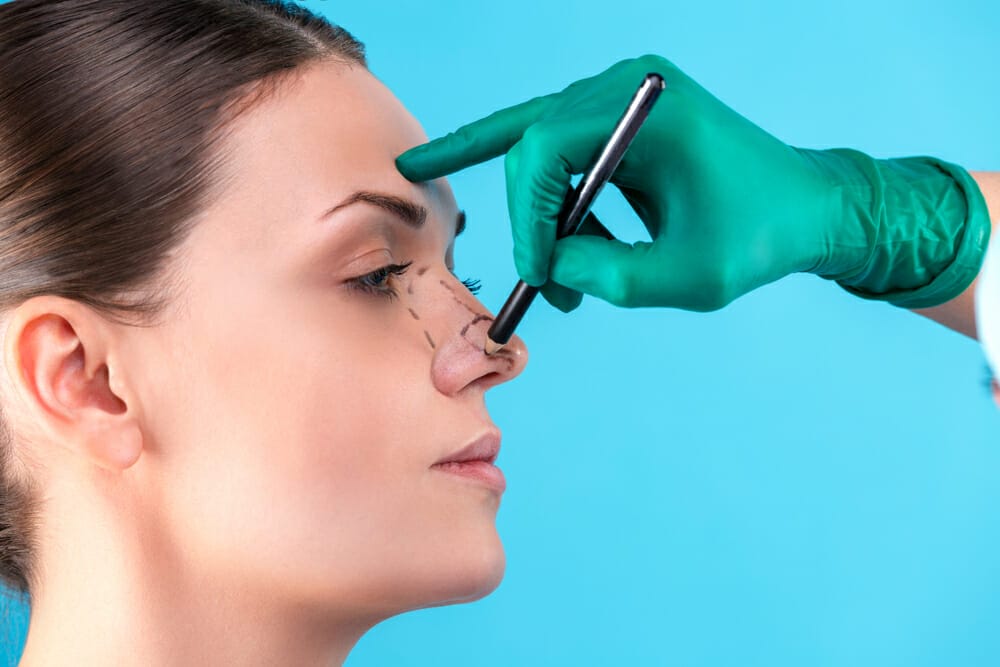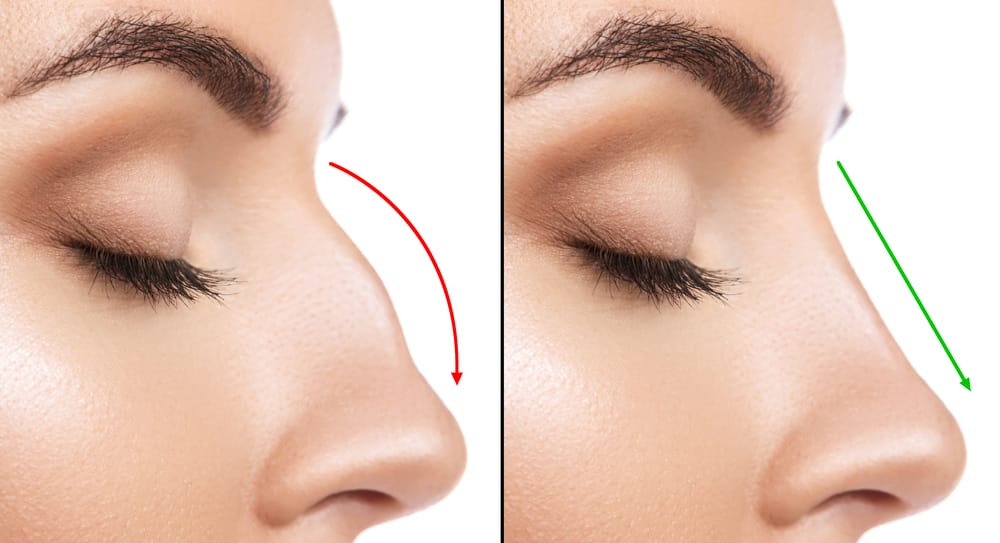La rhinoplastie, informations pratiques
- Type : modifie la taille et le type du nez
- Anesthésie : neuroleptanalgésie ou anesthésie générale
- Séjour : ambulatoire ou 24 h
- Désocialisation : 8 jours
- Les avantages : Elle permet d’obtenir un nez qui vous ressemble…

La rhinoplastie : objectifs
L’intervention se propose de modifier la morphologie de la pyramide nasale (soit partiellement, soit dans son ensemble) et vise aussi parfois à corriger d’éventuels problèmes de respiration nasale.
Une rhinoplastie peut être réalisée isolément ou être associée, si nécessaire, à d’autres gestes complémentaires au niveau de la face, en particulier à une génioplastie (modification du menton, parfois réalisée dans le même temps opératoire pour améliorer l’ensemble du profil).
Le but est d’obtenir un nez d’aspect naturel, s’harmonisant dans ses rapports avec les autres traits du visage, convenant à la psychologie et à la personnalité du patient, et répondant aux demandes de ce dernier.
Le principe est, à partir d’incisions dissimulées dans les narines, de remodeler l’os et le cartilage qui constituent l’infrastructure solide du nez et lui confèrent sa forme particulière. La peau recouvrant le nez devra se réadapter et se redraper grâce à son élasticité sur cette charpente ostéo-cartilagineuse qui a été modifiée. Ce dernier point souligne l’importance de la qualité de la peau dans l’obtention du résultat final. On comprend ainsi qu’une rhinoplastie ne laisse pas habituellement de cicatrice visible sur la peau.
Lorsqu’une obstruction nasale gênant la respiration existe, elle sera traitée dans le même temps opératoire, qu’elle soit due à une déviation de la cloison ou à une hypertrophie des cornets (formations osseuses présentes dans les fosses nasales).
L’intervention, pratiquée aussi bien chez la femme que chez l’homme, peut être effectuée dès la fin de la croissance, c’est-à-dire à partir d’environ 16 ans. Elle peut éventuellement être prise en charge par l’assurance maladie sous certaines conditions.
La rhinoplastie : avant l'intervention
- Les motivations et les demandes du patient auront été analysées.
- Une étude attentive de la pyramide nasale et de ses rapports avec le reste du visage aura été faite, ainsi qu’un examen endo-nasal. Un bilan pré-opératoire habituel est réalisé conformément aux prescriptions.
- Le médecin anesthésiste sera vu en consultation au plus tard 48 heures avant l’intervention.
- Aucun médicament contenant de l’aspirine ne devra être pris dans les 10 jours précédant l’intervention. L’arrêt du tabac est vivement recommandé avant l’intervention.Il est fondamental de rester à jeun (ne rien manger ni boire) 6 heures avant l’intervention.
La rhinoplastie : après l’intervention chirurgicale
Se faire refaire le nez est une demande courante en chirurgie esthétique. À la Clinique du Lac, le patient reçoit toujours une information claire sur les suites opératoires, les éventuelles cicatrices et le résultat attendu de l’opération.
Quelles sont les suites opératoires d’une rhinoplastie ?
Après une opération de chirurgie du nez, il est fréquent d’observer l’apparition d’ecchymoses (bleus ou hématomes), ainsi qu’un œdème du nez et des paupières (gonflement). Des saignements très modérés peuvent survenir durant les premières heures qui suivent l’intervention chez certains patients ou patientes. Les premiers jours, il peut aussi être difficile de respirer par le nez.
La gêne respiratoire liée à l’œdème peut persister durant quelques semaines, des sprays nasaux peuvent alors être utilisés pour la réduire. Il est tout à fait possible de se moucher et se nettoyer le nez.
Le chirurgien esthétique retire l’attelle de protection posée à la fin de l’opération au bout de 6 à 10 jours. Lors de cette consultation post opératoire, le chirurgien peut déjà apprécier les premiers résultats de la correction apportée, même si le nez reste gonflé et ne possède pas encore sa forme définitive.Pour votre confort, il est préférable de prévoir 7 jours de repos après une rhinoplastie. Vous devez éviter les efforts violents durant le mois qui suit l’intervention de chirurgie esthétique et protéger votre visage du soleil tant que les ecchymoses persistent.
Quelles sont les cicatrices après une rhinoplastie ?
Les cicatrices d’une rhinoplastie sont à peine visibles et varient selon la technique opératoire. Elles se situent le plus souvent à l’intérieur du nez (rhinoplastie par voie fermée) ou sur la columelle, espace situé entre les deux narines (rhinoplastie par voie ouverte). Les cicatrices peuvent aussi se situer dans le creux de l’aile du nez, dans le cas où les ailes du nez seraient épatées.
Si une greffe de cartilage a été nécessaire, des cicatrices additionnelles peuvent concerner une oreille (la cicatrice est alors cachée derrière l’oreille), le thorax ou le cuir chevelu. Le plus souvent, le chirurgien prélève les greffons au niveau de la cloison nasale, ce qui ne laisse pas de cicatrice et donc aucun préjudice esthétique.
Quel résultat attendre d’une rhinoplastie ?
Les premiers résultats d’une rhinoplastie s’apprécient généralement 3 mois après l’intervention pour la partie haute du nez, et 6 à 12 mois pour la partie inférieure et la pointe du nez.
L’aspect définitif de votre nez ne peut donc être jugé qu’au bout d’un an, voire un peu après en cas de peau épaisse.
Une opération de chirurgie esthétique modifie définitivement l’aspect de votre nez, avec pour objectif de rétablir une certaine harmonie au niveau de votre visage. Le résultat de cette correction est irréversible, mais le vieillissement facial peut entraîner une modification de la forme du nez, au fil des années.
Vous pensez qu’une rhinoplastie vous permettrait de vous réconcilier avec votre nez ? Prenez rendez-vous à la Clinique du Lac pour une consultation de chirurgie esthétique au cours de laquelle vous pourrez poser vos questions et faire part de vos attentes à votre chirurgien.

La rhinoplastie : type d'anesthésie et modalités d'hospitalisation
Type d’anesthésie
Habituellement l’intervention se pratique sous anesthésie générale. Toutefois, dans certains cas, une anesthésie locale approfondie par des tranquillisants administrés par voie intra-veineuse (anesthésie « vigile ») pourra suffire.
Le choix entre ces différentes techniques sera le fruit d’une discussion entre vous, le chirurgien et l’anesthésiste.
Modalités d’hospitalisation
L’intervention se pratique en « ambulatoire », c’est-à-dire en hospitalisation de jour avec une sortie le jour même après quelques heures de surveillance. Toutefois, selon les cas, une courte hospitalisation peut être préférable.

